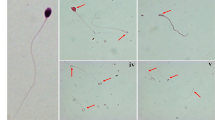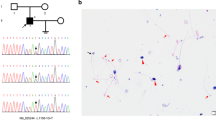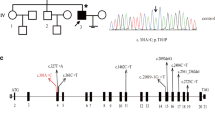Abstract
Acephalic spermatozoa syndrome (ASS) is a severe form of teratozoospermia, previous studies have shown that SUN5 mutations are the major cause of acephalic spermatozoa syndrome. This study is to identify the pathogenic mutations in SUN5 leading to ASS. PCR and Sanger sequence were performed to define the breakpoints and mutations in SUN5. Whole genome sequencing (WGS) was performed to detect heterozygous deletion. Western blotting and immunofluorescence analysis detected the expression level and localization of SUN5. Furthermore, the pathogenicity of the mutant SUN5 was predicted in silico and was verified by the experiments in vitro. We identified one novel homozygous missense mutation (c.775G>A; p.G259S) and one compound heterozygous including one reported missense mutation (c.1043A>T; p.N348I) and a large deletion that contains partial EFCAB8 (NM_001143967.1) and BPIFB2 (NM_025227) and complete SUN5 (NM_080675), and one recurrent homozygous splice-site mutation (c.340G>A; p.G114R) in SUN5 in three patients with ASS. Our results showed that SUN5 could not be detected in the patients’ spermatozoa and the exogenous expression level of the mutant protein was decreased in transfected HEK-293T cells. This study expands the mutational spectrum of SUN5. We recommended a clinical diagnostic strategy for SUN5 genomic deletion to screen heterozygous deletions and indicated that the diagnostic value of screening for SUN5 mutations and deletions in infertile men with ASS.



Similar content being viewed by others
Data Availability
Data and materials are available on request from the corresponding author.
References
Mascarenhas MN, Flaxman SR, Boerma T, Vanderpoel S, Stevens GA. National, regional, and global trends in infertility prevalence since 1990: a systematic analysis of 277 health surveys. PLoS Med. 2012;9(12):e1001356. https://doi.org/10.1371/journal.pmed.1001356.
Chemes HE, Puigdomenech ET, Carizza C, Olmedo SB, Zanchetti F, Hermes R. Acephalic spermatozoa and abnormal development of the head-neck attachment: a human syndrome of genetic origin. Hum Reprod. 1999;14(7):1811–8. https://doi.org/10.1093/humrep/14.7.1811.
Porcu G, Mercier G, Boyer P, Achard V, Banet J, Vasserot M, et al. Pregnancies after ICSI using sperm with abnormal head-tail junction from two brothers: case report. Hum Reprod. 2003;18(3):562–7. https://doi.org/10.1093/humrep/deg121.
Rondanino C, Duchesne V, Escalier D, Jumeau F, Verhaeghe F, Peers MC, et al. Evaluation of sperm nuclear integrity in patients with different percentages of decapitated sperm in ejaculates. Reprod BioMed Online. 2015;31(1):89–99. https://doi.org/10.1016/j.rbmo.2015.04.002.
Zhu F, Liu C, Wang F, Yang X, Zhang J, Wu H, et al. Mutations in PMFBP1 Cause acephalic spermatozoa syndrome. Am J Hum Genet. 2018;103(2):188–99. https://doi.org/10.1016/j.ajhg.2018.06.010.
Sha YW, Wang X, Xu X, Ding L, Liu WS, Li P, et al. Biallelic mutations in PMFBP1 cause acephalic spermatozoa. Clin Genet. 2019;95(2):277–86. https://doi.org/10.1111/cge.13461.
Zhu F, Wang F, Yang X, Zhang J, Wu H, Zhang Z, et al. Biallelic SUN5 mutations cause autosomal-recessive acephalic spermatozoa syndrome. Am J Hum Genet. 2016;99(4):942–9. https://doi.org/10.1016/j.ajhg.2016.08.004.
Sha YW, Xu X, Ji ZY, Lin SB, Wang X, Qiu PP, et al. Genetic contribution of SUN5 mutations to acephalic spermatozoa in Fujian China. Gene. 2018;647:221–5. https://doi.org/10.1016/j.gene.2018.01.035.
Fang J, Zhang J, Zhu F, Yang X, Cui Y, Liu J. Patients with acephalic spermatozoa syndrome linked to SUN5 mutations have a favorable pregnancy outcome from ICSI. Hum Reprod. 2018;33(3):372–7. https://doi.org/10.1093/humrep/dex382.
Sha YW, Sha YK, Ji ZY, Mei LB, Ding L, Zhang Q, et al. TSGA10 is a novel candidate gene associated with acephalic spermatozoa. Clin Genet. 2018;93(4):776–83. https://doi.org/10.1111/cge.13140.
Ye Y, Wei X, Sha Y, Li N, Yan X, Cheng L, et al. Loss-of-function mutation in TSGA10 causes acephalic spermatozoa phenotype in human. Mol Genet Genomic Med. 2020;8(7):e1284. https://doi.org/10.1002/mgg3.1284.
Liu G, Wang N, Zhang H, Yin S, Dai H, Lin G, et al. Novel mutations in PMFBP1, TSGA10 and SUN5: expanding the spectrum of mutations that may cause acephalic spermatozoa. Clin Genet. 2020;97(6):938–9. https://doi.org/10.1111/cge.13747.
Li L, Sha Y, Wang X, Li P, Wang J, Kee K, et al. Whole-exome sequencing identified a homozygous BRDT mutation in a patient with acephalic spermatozoa. Oncotarget. 2017;8(12):19914–22. https://doi.org/10.18632/oncotarget.15251.
Chen H, Zhu Y, Zhu Z, Zhi E, Lu K, Wang X, et al. Detection of heterozygous mutation in hook microtubule-tethering protein 1 in three patients with decapitated and decaudated spermatozoa syndrome. J Med Genet. 2018;55(3):150–7. https://doi.org/10.1136/jmedgenet-2016-104404.
Li L, Sha YW, Xu X, Mei LB, Qiu PP, Ji ZY, et al. DNAH6 is a novel candidate gene associated with sperm head anomaly. Andrologia. 2018;50. https://doi.org/10.1111/and.12953.
Shang Y, Yan J, Tang W, Liu C, Xiao S, Guo Y, et al. Mechanistic insights into acephalic spermatozoa syndrome-associated mutations in the human SUN5 gene. J Biol Chem. 2018;293(7):2395–407. https://doi.org/10.1074/jbc.RA117.000861.
Elkhatib RA, Paci M, Longepied G, Saias-Magnan J, Courbiere B, Guichaoua MR, et al. Homozygous deletion of SUN5 in three men with decapitated spermatozoa. Hum Mol Genet. 2017;26(16):3167–71. https://doi.org/10.1093/hmg/ddx200.
Dong Z, Jiang L, Yang C, Hu H, Wang X, Chen H, et al. A robust approach for blind detection of balanced chromosomal rearrangements with whole-genome low-coverage sequencing. Hum Mutat. 2014;35(5):625–36. https://doi.org/10.1002/humu.22541.
Li L, Chen H, Yin C, Yang C, Wang B, Zheng S, et al. Mapping breakpoints of a familial chromosome insertion (18,7) (q22.1; q36.2q21.11) to DPP6 and CACNA2D1 genes in an azoospermic male. Gene. 2014;547(1):43–9. https://doi.org/10.1016/j.gene.2014.06.007.
Gardner DKSW. In vitro culture of human blastocysts. In: Jansen R, Mortimer D, editors. Toward Reproductive Certainty: Fertility and Genetics Beyond 1999. London: Parthenon Publishing London; 1999. p. 378–88.
Acknowledgements
We would like to sincerely thank the patients and their families for their participation.
Funding
This study is funded by the National Natural Science Foundation of China, Grand/Award number: 82071701, 81972641; Natural Science Foundation of Anhui Province, Grand/Award number: 1908085J28; Key R&D program of Anhui Province, Grand/Award number: 201904a07020050; the Non-profit Central Research Institute Fund of Chinese Academy of Medical Sciences, Grand/Award number: 2019PT310002; Scientific Research Foundation of the Institute for Translational Medicine of Anhui Province, Grand/Award number: SRFITMAP 2017zhyx29, ZHYX2020A00.
Author information
Authors and Affiliations
Contributions
F.Z., Y.C. and F.W. conceived and designed the experiments. M.L., J.Z., Z.D. and X.Z. collected the samples. M.X., Y.W., K.W. and S.K. performed the experiments. M.X., Y.W., K.W., S.K., X.S., F.W., Y.C. and F.Z. analyzed the data. M.X. wrote the article. All authors approved the final article.
Corresponding authors
Ethics declarations
Ethics Approval
This study was approved by the ethics committee of Anhui Medical University. Written informed consent was obtained from each participant.
Consent to Participate
Obtained.
Consent for Publication
Obtained.
Competing Interests
The authors declare no competing interests.
Additional information
Publisher’s Note
Springer Nature remains neutral with regard to jurisdictional claims in published maps and institutional affiliations.
Rights and permissions
About this article
Cite this article
Xiang, M., Wang, Y., Wang, K. et al. Novel Mutation and Deletion in SUN5 Cause Male Infertility with Acephalic Spermatozoa Syndrome. Reprod. Sci. 29, 646–651 (2022). https://doi.org/10.1007/s43032-021-00665-5
Received:
Accepted:
Published:
Issue Date:
DOI: https://doi.org/10.1007/s43032-021-00665-5




